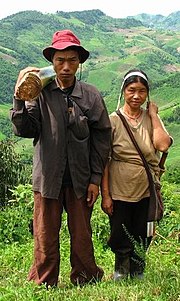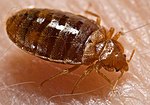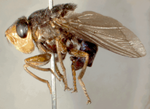treatment of human lice is the removal of head lice parasites from human hair. It has been debated and studied for centuries. However, the number of cases...
31 KB (3,424 words) - 21:46, 8 May 2024
Head lice infestation, also known as pediculosis capitis, is the infection of the head hair and scalp by the head louse (Pediculus humanus capitis). Itching...
37 KB (4,173 words) - 07:41, 28 August 2024
Pediculosis pubis (redirect from Pubic lice)
Karim; Doumbo, Ogobara K.; Raoult, Didier (2016). "Management and Treatment of Human Lice". BioMed Research International. 2016: 1–12. doi:10.1155/2016/8962685...
22 KB (2,448 words) - 10:08, 7 April 2024
Head louse (redirect from Head Lice)
ectoparasite of humans. Head lice are wingless insects that spend their entire lives on the human scalp and feed exclusively on human blood. Humans are the...
34 KB (3,705 words) - 18:08, 17 July 2024
Pediculosis (redirect from Lice infestations)
while this with body lice, pediculosis corporis. Although pediculosis in humans may properly refer to lice infestation of any part of the body, the term...
17 KB (1,657 words) - 14:36, 23 April 2024
Body louse (redirect from Body lice)
infests humans. It is one of three lice which infest humans, the other two being the head louse, and the crab louse or pubic louse. Body lice may lay...
17 KB (1,617 words) - 18:06, 26 July 2024
Crab louse (redirect from Crab Lice)
distantly related to the genus Pediculus, which contains the human head and body lice and lice that affect chimpanzees and bonobos. An adult crab louse is...
11 KB (1,267 words) - 22:11, 14 July 2024
Light, J.E.; Reed, D.L. (2011). "Origin of clothing lice indicates early clothing use by anatomically modern humans in Africa". Molecular Biology and Evolution...
266 KB (25,497 words) - 01:26, 29 August 2024
Lindane (category CS1 maint: DOI inactive as of January 2024)
and an isomer of hexachlorocyclohexane that has been used both as an agricultural insecticide and as a pharmaceutical treatment for lice and scabies. Lindane...
41 KB (4,061 words) - 23:45, 27 July 2024
Scabies (redirect from Human scabies)
PMID 18335094. "FDA Public Health Advisory: Safety of Topical Lindane Products for the Treatment of Scabies and Lice". Fda.gov. 30 April 2009. Archived from the...
52 KB (5,588 words) - 12:31, 16 August 2024
Permethrin (section Mechanism of action)
or lotion. It is indicated for the treatment and prevention in exposed individuals of head lice and treatment of scabies. It has an excellent safety...
39 KB (3,489 words) - 02:44, 29 August 2024
Ivermectin (section Mechanism of action)
heartworm and acariasis. Approved for human use in 1987, it is used to treat infestations including head lice, scabies, river blindness (onchocerciasis)...
79 KB (7,766 words) - 21:34, 23 August 2024
No nit policy (section The no-lice policy)
authorities to prevent the transmission of head lice infestation. The "no nit" policy requires the sending home and barring of all children who have nits (egg...
47 KB (5,378 words) - 06:40, 27 December 2023
Dipylidium caninum (category Parasitic helminths of humans)
organisms afflicted with fleas and canine chewing lice, including dogs, cats, and sometimes human pet-owners, especially children. The adult worm is...
12 KB (1,531 words) - 15:31, 13 February 2024
transmitted by ticks and members of the bacterial genus Rickettsia are transmitted by lice. For example, the human body louse transmits the bacterium...
8 KB (283 words) - 23:53, 21 July 2024
Epidemic typhus (category CS1 maint: DOI inactive as of June 2024)
infected lice. Clothes left unworn and unwashed for 7 days also result in the death of both lice and their eggs, as they have no access to a human host....
43 KB (4,994 words) - 22:27, 24 June 2024
Pediculosis corporis (category Lice)
caused by body lice (Pediculus humanus humanus) that lay their eggs on clothing and to a lesser extent on human hairs.: 447 Body lice can cause intense...
8 KB (718 words) - 13:30, 25 May 2024
Trichodectes canis (category Lice)
tend to move much slower than human lice, and may appear almost motionless. Trichodectes canis survives by consuming flakes of skin and fluids produced by...
8 KB (1,049 words) - 06:16, 21 January 2024
Ascaris lumbricoides (category Parasitic nematodes of humans)
lumbricoides is a large parasitic roundworm of the genus Ascaris. It is the most common parasitic worm in humans. An estimated 807 million–1.2 billion people...
16 KB (1,822 words) - 16:32, 23 July 2024
Bartonella (section Treatment)
to both animals and humans through various other vectors, such as fleas, lice, and sand flies. Bartonella bacteria are associated with cat-scratch disease...
19 KB (1,292 words) - 17:36, 24 July 2024
Bed bug (redirect from Health effects of bedbugs)
approximately 300 days without feeding. Repeated treatments of a home may be required. These treatments may include heating the room to 50 °C (122 °F) for...
68 KB (6,943 words) - 13:52, 1 September 2024
Trench fever (section Treatment)
"urban trench fever") is a moderately serious disease transmitted by body lice. It infected armies in Flanders, France, Poland, Galicia, Italy, Macedonia...
14 KB (1,534 words) - 01:25, 19 July 2024
Emamectin has also shown promising applications in the eradication of fish lice and in fish farming. Emamectin was invented by Regina D. Leseota, Pradip...
15 KB (1,266 words) - 15:49, 18 January 2024
Relapsing fever (section Treatment)
on ECG.[citation needed] Lice that feed on infected humans acquire the Borrelia organisms that then multiply in the gut of the louse. When an infected...
15 KB (1,630 words) - 01:58, 30 August 2024
Prevalence of IBS and Blastocystosis by country Roberts T, Stark D, Harkness J, Ellis J (May 2014). "Update on the pathogenic potential and treatment options...
26 KB (651 words) - 14:46, 18 August 2024
Dermatobia hominis (redirect from Human bot fly)
The human botfly, Dermatobia hominis (Greek δέρμα, skin + βίος, life, and Latin hominis, of a human), is a species of botfly whose larvae parasitise humans...
8 KB (859 words) - 10:41, 16 June 2024
Aphid (redirect from Plant lice)
The treatment of the groups especially concerning fossil groups varies greatly due to difficulties in resolving relationships. Most modern treatments include...
104 KB (11,372 words) - 19:15, 31 August 2024

























